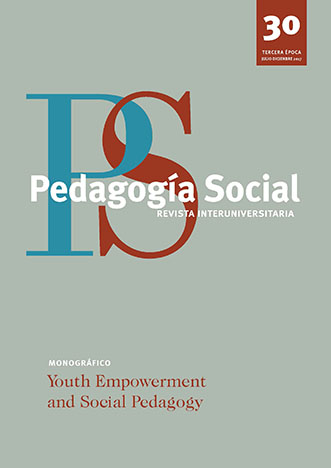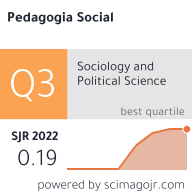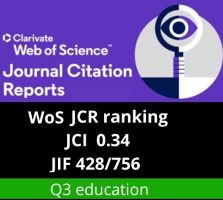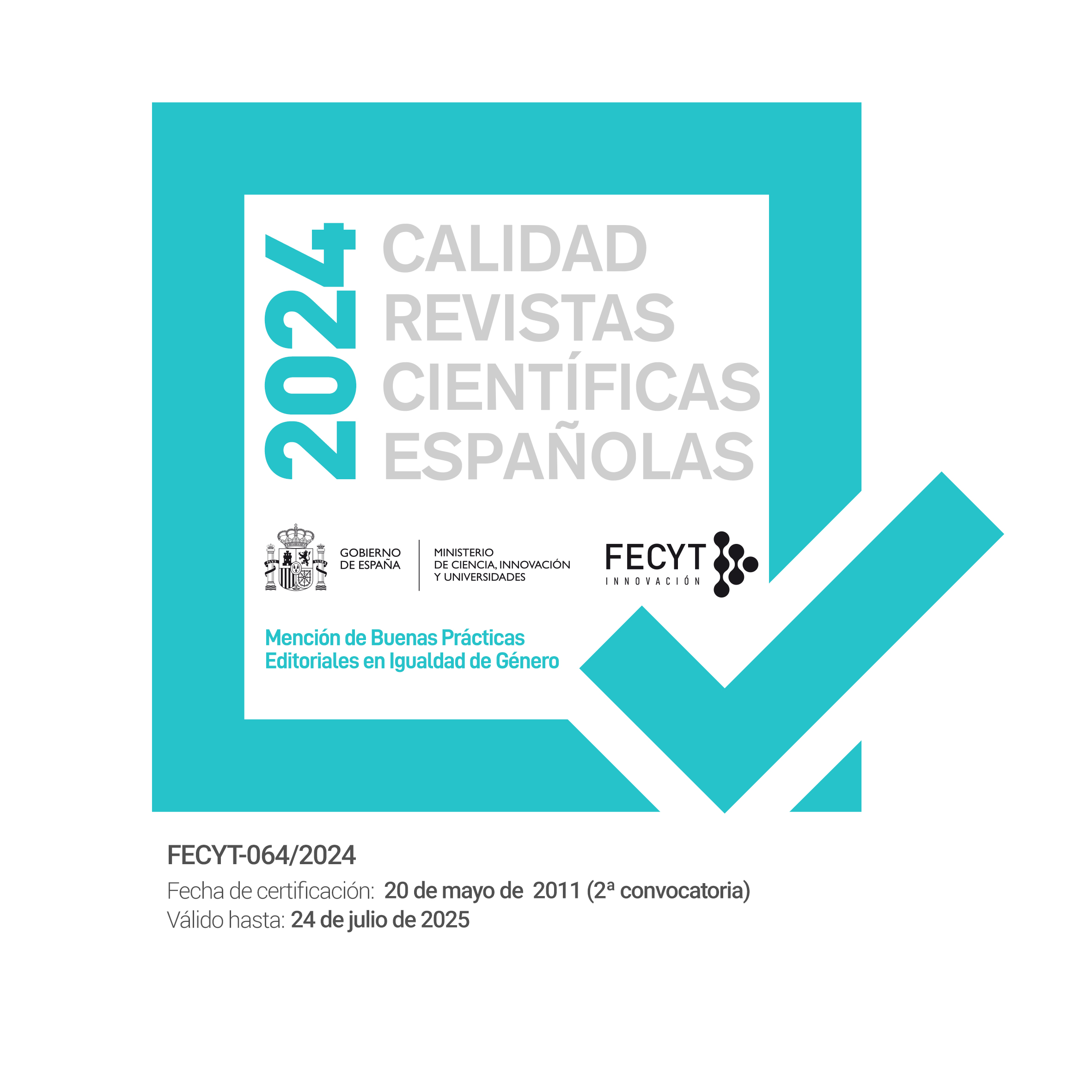Adults’ motivating factors to study a foreign language
DOI:
https://doi.org/10.7179/PSRI_2017.30.09Keywords:
intrinsic motivation, extrinsic motivation, lack of motivation learning, foreign languagesAbstract
This study arises from questioning the reasons why students study foreign lan¬guages and the variables that may influence their choice. The sample consists of 90 individu¬als enrolled in foreign language courses through the UNED Associated Center in Pontevedra. They are mostly women (70%), with an average age of 42.23. An adaptation of the Educational Motivation Scale (EME-E; Nunez, Martin-Albo and Navarro, 2005) was used as a research tool for this study. This new scale includes 28 items which assess three types of learning motivation (extrinsic motivation, intrinsic motivation and lack of motivation) and seven subtypes. Regard¬ing the motivation dimension (α = .87), the factor analysis determined that the seven subscales corresponding to knowledge-oriented intrinsic motivation, achievement-oriented intrinsic motivation, intrinsic motivation oriented towards stimulating experiences, external regulation, introjected regulation, identified regulation and lack of motivation are consistent for its con¬struct. A demographic questionnaire was also used to collect information on gender, age and education level. Descriptive and inferential analyses of the data were performed. The results show significant differences between the variables under study. They pointed out the impor¬tance of encouraging intrinsic motivation and professors’ role in motivating students’ learning process. This clearly shows the need for faculty training programs. The discussion revolves around potential implications of motivational nature, based on students’ job, age, and gender, to learn foreign languagesDownloads
References
Baker, S. C., & MacIntyre, P. D. (2000). The Role of Gender and Immersion in Communication and Second Language Orientations. Language Learning, 50 (2), 311-341.
Barrios Espinosa, E. (2015). La incidencia del sexo, del nivel de competencia en inglés y del grado de motivación en percepciones sobre el aprendizaje a través de una aplicación en línea. Educación XX1, 18 (1), 283-302. doi: 10.5944/ educ XX1. 18.1.12333.
Bernaus, M., & Gardner, R. C. (2009). Teacher Motivation Strategies, Student Perceptions, Student Motivation, and English Achievement. The Modern Language Journal, 92 (3), 387-401.
Blanco, M., Pino, M., & Rodríguez, B. (2010). Ventajas en la incorporación de estrategias de aprendizaje en la enseñanza de idiomas. Estudio cualitativo. Revista de Innovación Educativa, 20, 61-71.
Brière, N. M., Vallerand, R. J., Blais, M. R., & Pelletier, L. (1995). Développement et validation d’une mesure de motivation intrinsèque. extrinsèque et d’amotivation en contexte sportif: l’Echelle de Motivation dans les Sports (EMS). International Journal of Sport Psychology, 26, 465-489.
Brown, H. D. (1990). M & Ms for language classroom? Another look al motivación. En Georgetow University Round tableo n Languages and Linguistics. ALATIS, J. E. (ed.), 383-93, Washington, DC, Georgetown University Press.
Cohen, J. (1988). Statistical power analysis for the behavioral science. Hillsdale, NJ: Lawrence Erlbaum Associates.
Cuenca París, M. E., & Ortega Sánchez, I. (2015). La enseñanza-aprendizaje de los alumnos mayores universitarios: Valoración de la función docente. Pedagogía Social. Revista Interuniversitaria 26, 285-313 Retrieved from http://www. upo.es/revistas/index.php/pedagogia_social/. DOI: 10.7179/PSRI_2015.26.11.
Deci, E. L., & Ryan, R. M. (2000). The “What” and “Why” of Goal Pursuits: Human Needs and the Self-Determination of Behavior. Psychological Inquiry, 11 (4), 227-268.
Dörnyei, Z., & Ushioda, E. (2011). Teaching and Researching Motivation (2ª ed.). Harlow. Reino Unido: Longman.
Khodadady, E., & Hassan Khajavy, G., (2014). Exploring the Role of Anxiety and Motivation in Foreign Language Achievement: A Structural Equation Modeling Approach. Revista Porta Linguarum, 20, 269-286.
García Sánchez, M. E., & Cruz Vargas, M. L. (2013). Factores motivacionales extrínsecos e intrínsecos en el aula de inglés: análisis empírico. Revista Porta Linguarum 19, 275-297.
Gardner R. C. y Lambert W. E. (1972). Attitudes and Motivation in Second Language Learning. Rowley, Massachusetts: Newbury House.
González-Peiteado, M. (2013). Los estilos de enseñanza y aprendizaje como soporte de la actividad docente. Revista Estilos de Aprendizaje, 11, 51-70.
González-Peiteado, M., & Pino-Juste, M. (2014). Aproximación a las representaciones y creencias del alumnado de magisterio sobre los estilos de enseñanza. Revista Educación XX1, 17 (1), 81-110. doi: 10.5944/educxx1.17.1.10706.
González-Peiteado, M., & Rodríguez-López, B. (2014). La formación inicial de los profesores de Lengua Extranjera: un espacio para generar estilos de actuación. Revista Bordón, 66 (4), 69-85.
González-Peiteado, M., & Rodríguez-López, B. (2015). Perceptions about Teaching Styles in the Development of a Teacher Profile. The International Journal of Educational Organization and Leadership, 22 (4), 29-43.
Guillén, F., Pérez Luzardo, J., & Arnaiz, A. (2013). Relación entre motivación y optimismo disposicional en aprendices de inglés como lengua extranjera en un contexto universitario. Revista de Educación, Extraordinario, pp. 104-128 doi: 10.4438/1988-592X-RE-2013-EXT-243.
Lirio Castro, J., & Morales Castro, S. (2012). El reto de la formación del profesorado para una enseñanza de calidad en las universidades de mayores. Pedagogía Social. Revista Interuniversitaria, 19, 155-166. Retrieved from http://www. upo.es/revistas/index.php/pedagogia_social/article/view/76.
Liu, M., & Huang, W. (2011). An exploration of foreign language anxiety and English learning motivation. Education Research International, 12, 1-8.
Liuolienė, A. and Metiūnienė, R. (2006). Second language learning motivation. Santalka. Filologija. Edukologija, 14 (2) 93-98.
Martínez Lirola, M. (2005). ¿Qué relación guarda la motivación con los problemas de disciplina durante la adolescencia en los programas de educación bilingüe en EEUU? Porta Linguarum 3, 21-3
Medrano, L. A., & Pérez, E. (2010). Adaptación de la Escala de Satisfacción Académica a la Población Universitaria de Córdoba. SUMMA Psicológica UST, 7 (2), 5-14
Morales, P. (2010). El tamaño del efecto (effect size): análisis complementarios al contraste de medias. En P. Morales, Estadística aplicada a las Ciencias Sociales. http://www.upcomillas.es/personal/peter/investigacion/Tama%F1oDelEfecto.pdf
Núñez Alonso, J. L., Martín-Albo Lucas, J., & Navarro Izquierdo, J. G. (2005). Validación de la versión española de la Échelle de Motivation en Éducation. Psicothema, 17, 344-349.
Núñez Alonso, J. L., Martín-Albo Lucas, J., & Navarro Izquierdo, J. G. (2006). Validación de la Escala de Motivación Educativa (EME) en Paraguay. Revista Interamericana de Psicología/Interamerican Journal of Psychology, 40, 391-398.
Pintrich, R., & Schunk, D. (2006). Motivation in Education: Theory, Research an Application. Nueva Jersey: Merrill Prentice Hall.
Pino, M., & Rodríguez, B. (2010). Tipología y frecuencia del uso de estrategias en el aprendizaje del inglés como lengua extranjera. Revista de Enseñanza, 27, 171-191.
Sánchez-López, M.C.; García-Sánchez, F.A.; Martínez-Segura, M.J. y Mirete, A. (2012). Aproximación a la valoración que el alumnado hace de recursos online utilizados para la docencia universitaria. Píxel Bit. Revista de Medios y Educación, 40, 35-45.
Saravia, E., & Bernaus, M. (2008). Motivación y actitudes para el aprendizaje de lenguas de dos colectivos de estudiantes universitarios: futuros maestros de lenguas extranjeras y futuros enfermeros y fisioterapeutas. Porta Linguarum 10, 163-184.
Ramos Nieto, M. C. (2011). La motivación en la enseñanza del inglés como lengua extranjera. Revista Aula y Docentes, 32, 39-49.
Richer, S. F., Blanchard, C. M., & Vallerand, R. J. (2002). A motivational model of work turnover. Journal of Applied Social Psychology, 32 (2), 2089-2113.
Rodríguez-Pérez, N. (2014). Creencias y representaciones de los profesores de lenguas extranjeras sobre la influencia de los factores motivacionales y emocionales en los alumnos y en las alumnas. Revista Porta Linguarum 21, 183-197.
Schwinger, M., Steinmayr, R., & Spinath, B. (2012). Not all roads lead to Rome-Comparing different types of motivational regulation profiles. Learning and Individual Differences, 22, 269-279.
Valle, A.; Regueiroa, V.; Rodríguez, S.; Piñeiro, I.; Freire, C.; Ferradás, M., & Suárez, N. (2015). Perfiles motivacionales como combinación de expectativas de autoeficacia y metas académicas en estudiantes universitarios. European Journal of Education and Psychology, 8 (1) 1-8.
Vallerand, R. J. (1997). Toward a Hierarchical Model of Intrinsic and Extrinsic Motivation. En M. P. Zanna (ed.), Advances in Experimental Social Psychology, 271-360. Nueva York: Academic Press.
Vallerand, R. J., & Bissonnette, R. (1992). Intrinsic, extrinsic, and, amotivational styles as predictors of behavior: A prospective study. Journal of Personality, 60, 599-620.
Vallerand, R. J., Blais, M. R., Briere, N. M., & Pelletier, L. G. (1989). Construction et validation de l’échelle de motivation en éducation (EME). Canadian Journal of Behavioural Sciences, 21, 323-349.
Vallerand, R. J., Pelletier, L. G., Blais, M. R., Brière, N. M., Senécal, C., & Vallières, E. F. (1992). The Academic Motivation Scale: a Measure of Intrinsic, Extrinsic and Amotivation in Education. Educational and Psychological Measurement, 52, 1003-1017.
Wijnia, L.; Loynes, S. M. M., & Derous, E. (2011). Investigating effects of problem- based versus lecture-based learning environments on student motivation, Contemporary Educational Psychology, 36 (2), 101-113.
Wong, R. M. (2014). Motivation to Learn English and School Grade Level: The Case of Newly Arrived Hong Kong Students. Revista Porta Linguarum 21, 37-50.
Zenotz, V. (2012). Motivación en el aprendizaje de una lengua. Estado de la cuestión. Huarte de San Juan. Revista de la Facultad de Ciencias Humanas y de la Lengua, 75-81. Universidad Pública de Navarra.
Downloads
Additional Files
Published
How to Cite
Issue
Section
License
Copyright (c) 2017 Pedagogía Social. Revista Interuniversitaria

This work is licensed under a Creative Commons Attribution-NonCommercial-ShareAlike 4.0 International License.
Copyright and right to archive
The published version of the articles can be self-archived by their authors in open access institutional and thematic repositories. However, Pedagogía Social. Revista Interuniversitaria must authorize partial or global reutilisation on new papers or publications.
Published papers must be cited including the title of the journal Pedagogía Social. Revista Interuniversitaria, issue, pages and year of publication
Ethical responsibilities
Pedagogía Social. Revista Interuniversitaria does not accept any material that has been previously published in other documents or publications. Authors are responsible for obtaining the required permissions for partial or global reproduction any material from other publications, and to correctly quote its origin.
Pedagogía Social. Revista Interuniversitaria is obliged to detect and report fraudulent practices.
Only those who have intellectually contribute to the development of the paper must appear as authors.
The journal expects authors to declare any commercial partnership that might entail a conflict of interest with respect to the submitted article.
Authors must mention in the article, preferably in the “methodology” section, that the procedures used during the samplings and controls have been made after getting informed consent.
The journal will not use any received contribution in a way other than the goals described in these guidelines.
Copyright Notice
© Pedagogía Social. Revista Interuniversitaria. Papers published in both the printed and online versions of this Journal are property of Pedagogia Social. Revista Interuniversitaria, being required to cite the source in any partial or total reproduction.
Unless otherwise stated, all content of this electronic journal is distributed under "Creative Commons Attribution-Non commercial 3.0 Spain" (CC-by-nc) license for use and distribution. The informative version and the legal text of this license is available here. This has to be expressly stated in this way when necessary.






